
New Items - Steamboats in the Movies
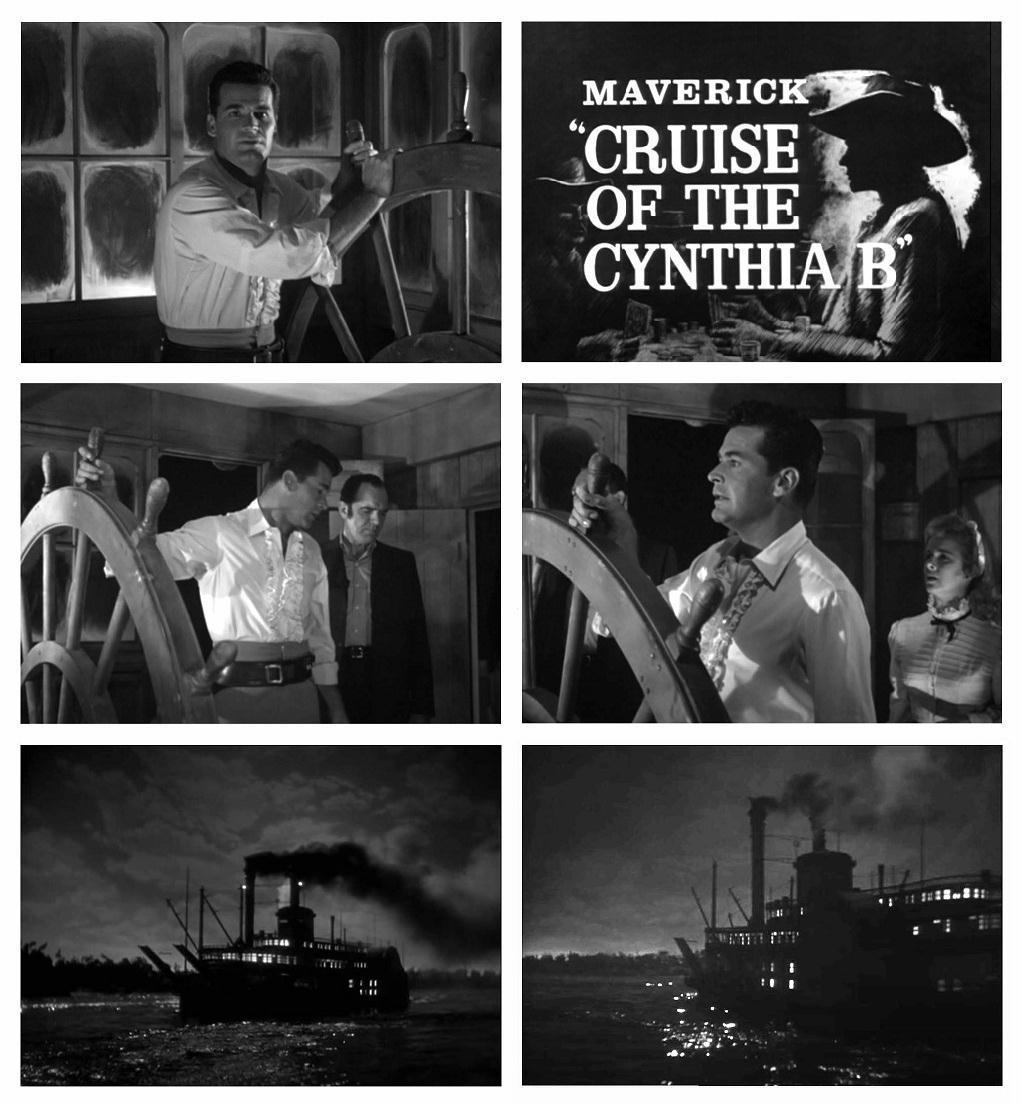
From "MAVERICK"
The Warner Bros. Western T.V. series
"Cruise of the Cynthia B."
Season 3
Episode 17
Broadcast 10 January 1960
Above are 6 screen captures from the episode with James Garner as Bret Maverick at the pilot wheel. The visual effects of the steamboat in the bottom 2 frames came from the MAVERICK episode STAMPEDE Season One 1 Episode 9. The footage was originally filmed for Warner's 1944 "Biopic" THE ADVENTURES OF MARK TWAIN.
Observations by Mike Grost of André De Toth's directing of the episode follows:
mikegrost.com
Cruise of the Cynthia B (1960) is an episode of the Maverick television series, directed by André De Toth. It is a pleasant whodunit, with atmospheric ship board scenes. It is nicely crafted, an example of the superior whodunit mysteries sometimes featured on Maverick. It has suspense, something frequently found in De Toth's noir films. The relentless suspicion the characters have towards each other, is a convention of whodunits. It also recalls the constant suspicion shown towards the hero of Riding Shotgun.
Having been tricked into buying a share of a steamboat instead of the whole boat, Bret Maverick and his co-owners sail up the Mississippi from Memphis to St. Louis to an interested purchaser. Along the way some of the co-owners are murdered by an unknown assailant.
Director: André De Toth
Writer: R. Wright Campbell
Cast
James Garner . . . . Bret Maverick
Jack Kelly . . . . Bart Maverick
Karl Weber . . . . Quincy T. Smith
Maurice Manson . . . . Rutherford Carr
Irene Tedrow . . . . Mrs. Ambrose Tutwiller
Gage Clarke . . . . Montgomery Teague
Jack Livesey . . . . Gillespie MacKenzie
Charles Fredericks . . . . Jefferson Cantrell
Alexander Campbell . . . . Abner Morton
Fred Kruger . . . . Meacham
Mona Freeman . . . . Modesty Blaine
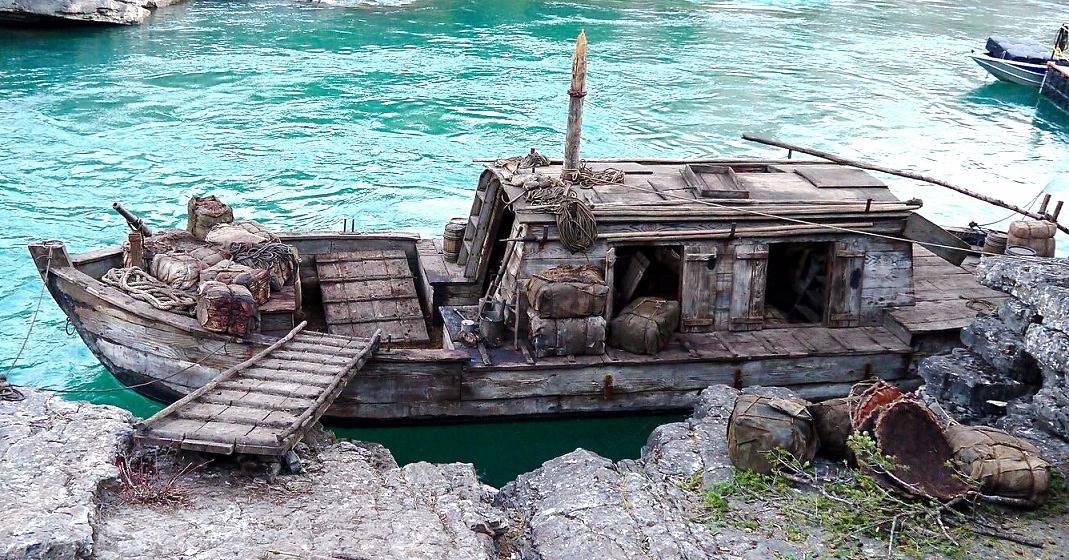
The trapper's keelboat for motion picture THE REVENANT
Inspired by true events and winner of three Oscars® (Actor, Cinematography and Directing), the 2015 motion picture THE REVENANT was based on the adventures of frontiersman, fur trapper, trader, hunter and explorer Hugh Glass (1783 - 1833).
THE REVENANT was set in part on the forbiddingly cold tributaries of the lonely upper reaches of the Missouri River. They were the waterways used for centuries by that area's Indian tribes. Now they were shared, usually unwillingly, with the region's Indian tribes' new trading rivals: European fur traders and mountain-men such as Hugh Glass. cliomuse.com
The trapper's keelboat was constructed around an aluminum hull and a 300-horsepower jet engine. "You would never know looking at the boat that there was an engine in it or any aluminum," photographer Jack Fisk says. "It was so beautifully aged and painted that it looked like it was rotting."
(From January 27, 2016 ARCHITECTURAL DIGEST article):
architecturaldigest.com
SET DESIGN
Leonardo DiCaprio's New Movie, THE REVENANT
Production designer Jack Fisk talks to Architectural Digest
about bringing the 19th-century frontier to life in
Alejandro González Iñárritu's film
By Elizabeth Stamp
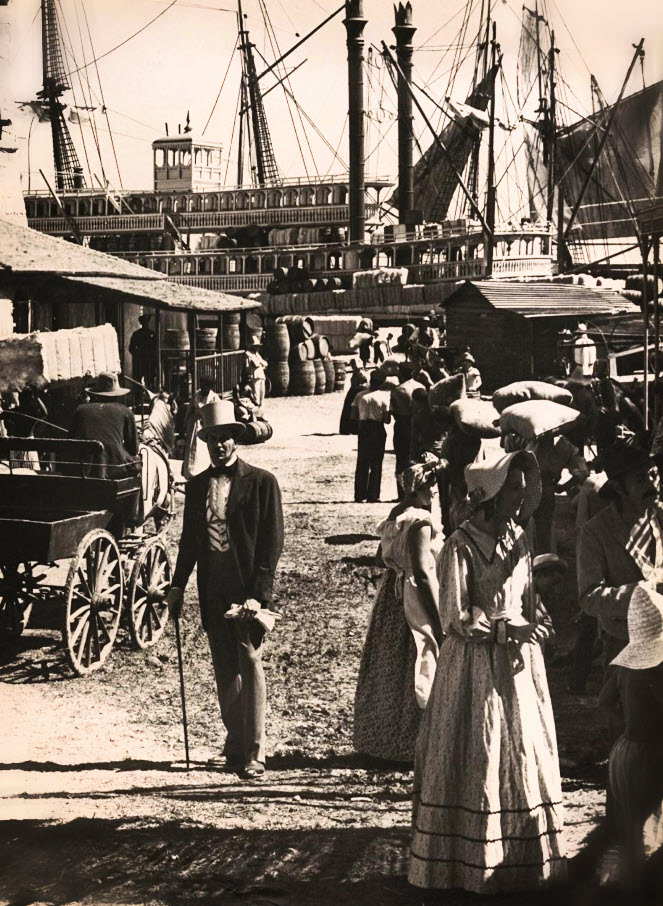
Vincent Price on New Orleans waterfront set for ADVENTURES OF CAPTAIN FABIAN 1951
Vincent Price as "George Brissac" stands with top hat and cane in an outdoor set representing New Orleans that was built in the French city of Villefranche for a 1951 motion picture ADVENTURES OF CAPTAIN FABIAN (alternate title NEW ORLEANS ADVENTURE) filmed in France.
The mock up of a large steamboat is featured prominently at the top of the photo. It is not known how the art department created this item since it could also have been a scale model that was suspended close to the motion picture camera with a deep focus lens that would create the illusion of a full scale steamboat replica in the distance.
wikipedia
ADVENTURES OF CAPTAIN FABIAN(alternate title NEW ORLEANS ADVENTURE) is a 1951 American film directed by William Marshall and starring Errol Flynn, Micheline Presle, Vincent Price, Agnes Moorehead and Victor Francen.
The plot is about the travails of a French Creole maid in a household of 1860 New Orleans and her romantic involvement with Captain Fabian.
An ambitious girl (Micheline Presle) uses a sea captain (Errol Flynn) to climb the social ladder in old New Orleans.
Cast
Errol Flynn as Captain Fabian
Micheline Presle as Lea Mariotte
Vincent Price as George Brissac
Agnes Moorehead as Aunt Jezebel
Victor Francen as Henri Brissac
Jim Gérald as Commissioner Germain
Héléna Manson as Josephine
Howard Vernon as Emile
Roger Blin as Philippe
Production
The film was originally known as the THE BARGAIN and based on a script by Errol Flynn himself.
At one stage the film was also known as BLOODLINE and NEW ORLEANS ADVENTURE.
Filming began on July 15, 1950 in Paris. Exteriors representing New Orleans were recreated in the city of Villefranche with studio scenes shot at the Victorine Studios in Nice and the Billancourt Studios in Paris.
wikipedia
The French city of Villefranche-sur-Mer is immediately to the east of the city of Nice, along Mont Boron, Mont Alban and Mont Vinaigrier, and 6.2 miles south-west of Monaco. The bay of Villefranche is one of the deepest natural harbours of any port in the Mediterranean Sea and provides safe anchorage for large ships from easterly winds. Reaching depths of 320 feet between the Cape of Nice and Cap Ferrat; it extends to the south to form a 1,700 fOOT abyss known as the undersea Canyon of Villefranche at about one nautical mile off the coastline.
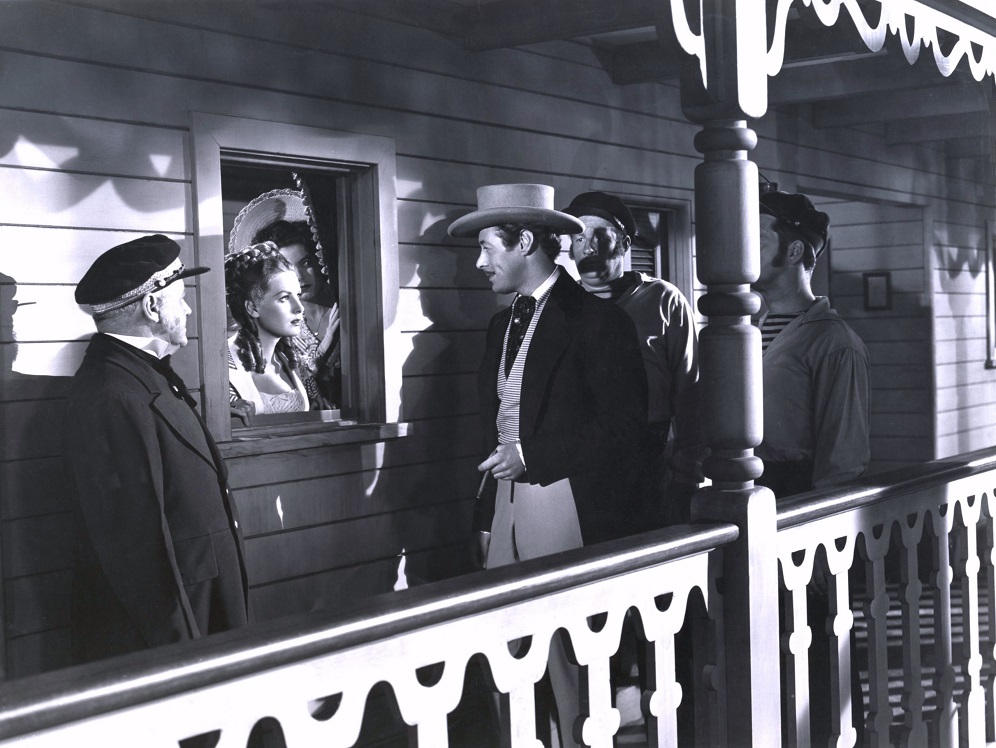
THE FOXES OF HARROW 1947 Steamboat boiler deck Rex Harrison & Maureen O'Hara
The Foxes of Harrow
Rex Harrison as Stephen Fox and Maureen O'Hara as Odalie 'Lilli' D'Arceneaux aboard a steamboat in an early sequence in the movie where gambler Stephen Fox is about to be stranded on a sandbar in the Mississippi River where he is later rescued by flatboat Captain Mike Farrell played by Victor McLaglen.
In 1827, Stephen Fox (Rex Harrison), illegitimate child of the illustrious Irish Harrow family, is a successful young gambler in New Orleans. Attracted to beautiful aristocratic Creole Odalie D'Arceneaux (Maureen O'Hara), Stephen instigates a duel when her name is sullied. He is wounded in the quarrel, but he also wins a plantation -- and gains Odalie's affections. The two marry, and Stephen builds up the plantation, but the couple faces tumult and heartbreak in their life together.
- From Wikipedia, the free encyclopedia:
The Foxes of Harrow is a 1947 adventure film directed by John M. Stahl. The film stars Rex Harrison, Maureen O'Hara, and Richard Haydn.
The film was nominated for the Academy Award for Best Production Design (Lyle R. Wheeler, Maurice Ransford, Thomas Little, Paul S. Fox).
The storyline was derived from the 1946 novel The Foxes of Harrow by Frank Yerby which was set in romantic New Orleans and nearby plantation life, from 1825 to 1865.
Fox paid author Frank Yerby $150,000 for the motion picture rights to The Foxes of Harrow, which was his first novel. A December 1947 Ebony article called the figure "the biggest bonanza ever pocketed by a colored writer" and stated that the book was "the first Negro-authored novel ever bought by a Hollywood studio."
In pre-Civil War New Orleans, roguish Irish gambler Stephen Fox (Rex Harrison) buys his way into society - something he couldn't do in his homeland because he is illegitimate.
Cast
Rex Harrison as Stephen Fox
Maureen O'Hara as Odalie 'Lilli' D'Arceneaux
Richard Haydn as Andre LeBlanc
Victor McLaglen as Captain Mike Farrell
The Foxes of Harrow
Directed by - John M. Stahl
Produced by
William A. Bacher
Darryl F. Zanuck
Screenplay by
Wanda Tuchock
Dwight Taylor
Edwin Justus Mayer
Thomas Job
Based on - The Foxes of Harrow, a 1946 novel
by Frank YerbyMusic by - David Buttolph
Cinematography - Joseph LaShelle
Edited by - James B. Clark
Distributed by - 20th Century Fox
Release date - 24 September 1947
Running time - 117 minutes
Country - United States/United Kingdom
Language - English
Budget - $2,750,000
Box office - $3,150,000 (US rentals)
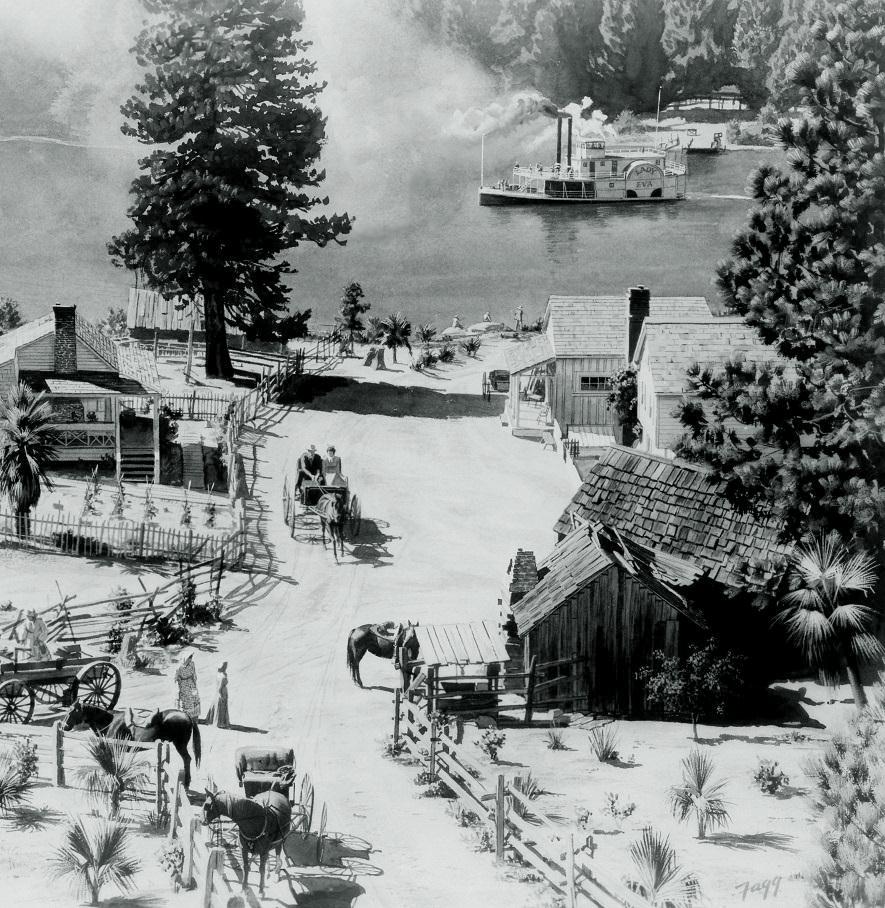
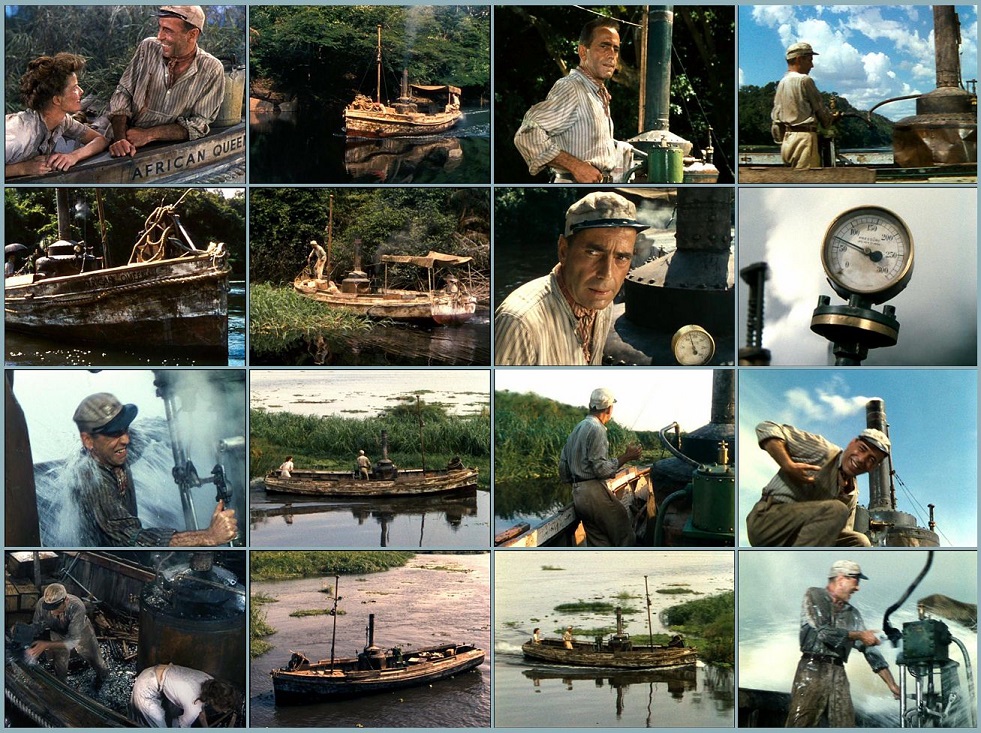
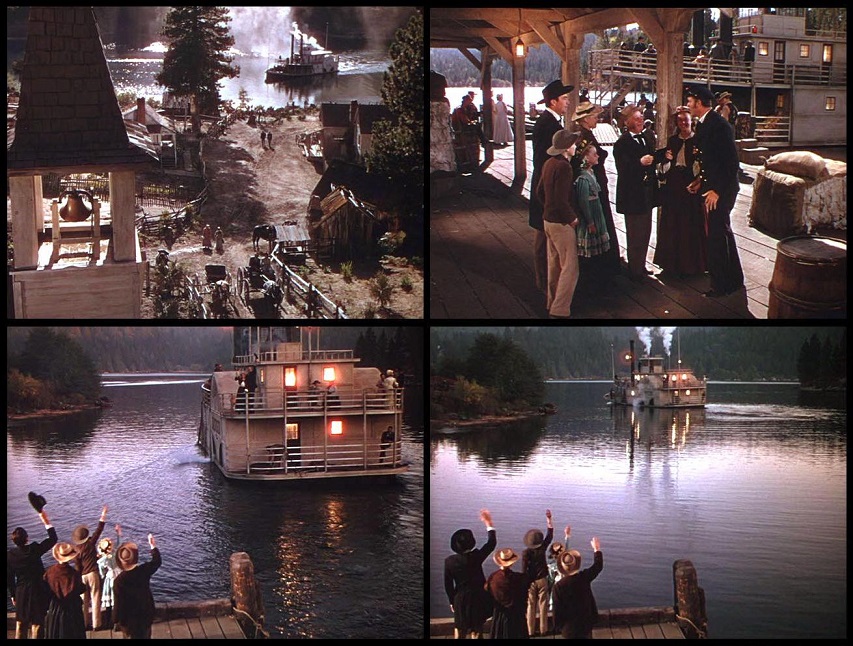
The Yearling 1946 watercolor of Florida village and theSteamboatLADY EVA filmed at Lake Arrowhead
Detail of an incredibly realistic watercolor by Ken Fagg of the Lake Arrowhead set for the steamboat sequence filmed in the San Bernadino Mountains for the MGM feature film THE YEARLING in 1946
Steamboat LADY EVA LakeArrowhead Illustration by Ken Fagg
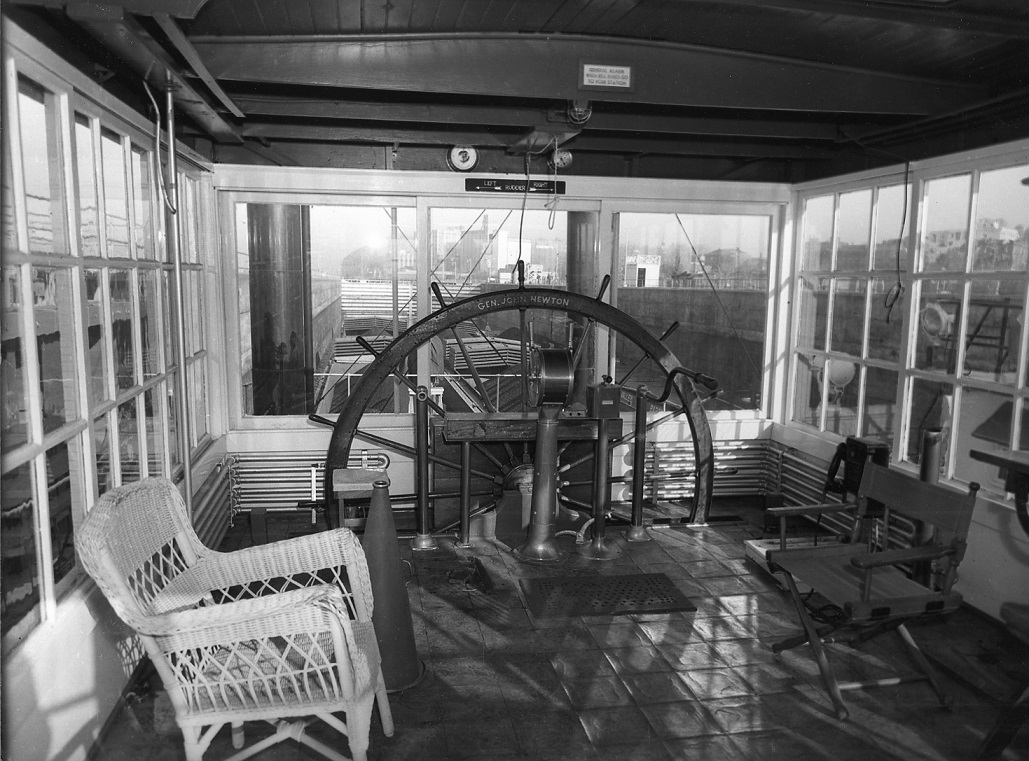
Pilot House GENERAL JOHN NEWTON interior by Bob Graul
Pilot House GENERAL JOHN NEWTON photograph of the interior by Bob Graul. This seems to have been taken in a lock where the Newton was secured among barges being pushed by a towboat, possibly en route up river to St. Paul, Minnesota where after she was retired the NEWTON became a showboat for U. of Minnesota.
In Memoriam
Robert K. Graul
Alton, Illinois Photographer & River Historian
In Memoriam - Mr. Robert K. Graul - Alton, Illinois Photographer & River Historian - Message Boards (steamboats.org)
9-04-2007
Sad news has come of the passing, on Friday, August 31st, of Mr. Robert K. Graul, beloved and well known photographer of Alton, Illinois, at age 94. Bob was the very gentlemanly and chief photographer for "The Alton Telegraph" for 41 years and had a special interest in the river. His photos are fabulous and he was especially proud of having documented the construction of the original Locks and Dam #26 and their replacement.
He captured on film the transition from steam to diesel on the river and took many images of the Streckfus excursion steamboats, the Str. Golden Eagle and hundreds of other vessels that passed up and down the Mississippi at his doorstep. Many of his fine pictures are in the collections at the Alton Museum of History of Art, of which he was a longtime supporter (particularly of the River Room) and at the Hayner Public Library.
Bob is survived by one son, marine architect Tim Graul, of Sturgeon Bay, Wisconsin, three daughters, eight grandchildren and four great grandchildren. Bob's wife, Isabel, who was a church organist, preceded him in death in 2003.
A kind and gentle soul, Mr. Bob will be missed by all who were privileged to know him. A whistle salute to his memory and with much gratitude for the legacy he leaves us in preserving our river heritage.
Last edited by Keith Norrington; 09-05-2007, 10:16 AM.
Kate Adams
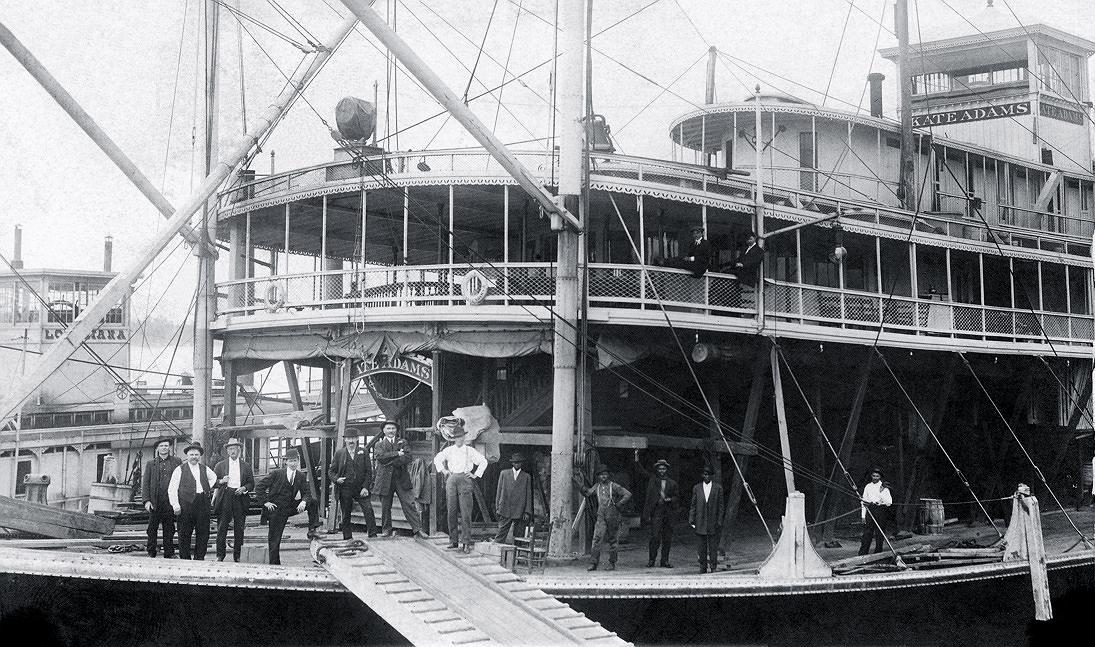
The KATE ADAMS - Scanned from a real photo.
(The 3rd steamboat by the name KATE ADAMS) as she looked prior to being remodeled to portray the antebellum steamboat "La Belle Riviere" for the 1927 silent film version of Harriet Beecher Stowe's 1852 novel UNCLE TOM'S CABIN.
Built in 1899 at Howard Shipyards in Jeffersonville, Indiana
240 feet X 7 feet
January 8,1927 burned at the levee Memphis, Tennessee
Captains:
Grant Marsh was Captain from 1900 to 1902
William Hodges was Captain when the KATE ADAMS was stranded on June 3rd, 1917
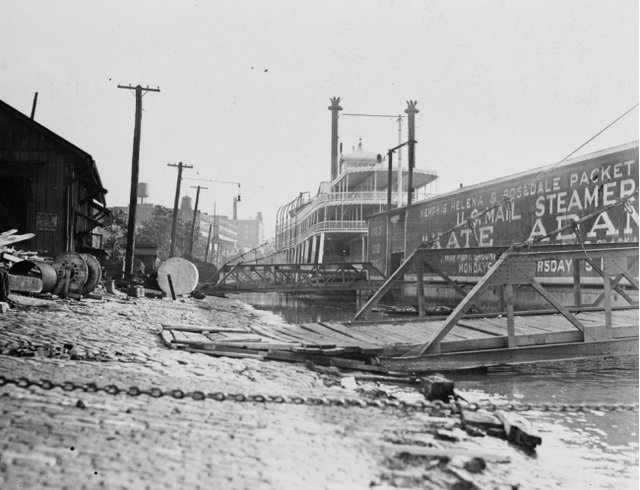
The End of "The Lovin' Kate" — the S.S. Kate Adams
by Vance Lauderdale
May 3, 2011
MEMPHIS - THE CITY MAGAZINE
memphismagazine.com
With all our attention nervously focused on the river these days, I thought I'd lighten the mood by telling the story of the Kate Adams. It's not a happy story, but compared to what happened to her, it will lessen our own troubles, you see.
The Kate Adams — actually the third riverboat with that name here — was built in Pittsburgh in 1898. The big sidewheeler was 240 feet long, with a pair of tall smokestacks, three grand decks, and a main cabin stretching more than 175 feet, that was lighted with newfangled electric chandeliers. When the foundry cast her great bell, the new boat's captain dumped 2,000 silver dollars into the mold to give it a more "silvery" tune. Workers along the river swore they could recognize that distinctive clang 14 miles away. Or so they said. I'd give it 12 miles, tops.
Some 2,000 people greeted the Lovin' Kate, as the boat came to be known, when she first arrived here to join the Memphis and Arkansas River Packet Company. The Kate ferried cotton, cargo, and passengers up and down the river and became so popular that one day — so the story goes — a Sunday School teacher asked a student, "Who was the first man?"The boy quickly replied, "Adam." And when asked who was the first woman, the boy thought it over a bit and said, "Uh — Kate Adams?"
Do you believe this story? No, neither do I. How do such silly tales get started?
New railroads, fast trucks, and improved highways began to cut into river traffic, however, and in the 1920s the Kate was shuffled off to work other routes on the upper Mississippi and Ohio rivers. In 1926, though, she returned south to "star" in a silent movie being filmed here, Uncle Tom's Cabin. Most of the movie was shot in Natchez, and the Kate came back to Memphis when filming was over. She was tied up on the riverfront at the foot of Monroe on the night of January 8, 1927, when flames began crackling from one of her lower decks.
In a matter of hours the big wooden boat was burned to ashes, leaving nothing in the water but the smoldering steel hull. A reporter of that time lamented, "Sole survivor of the elegance, the beauty, and the romance of a hundred years in the history of the western waters, the steamer Kate Adams, third of her illustrious line, has cleared the Memphis landing for all time." Investigators never found a cause for the blaze.
The boat's owner salvaged the bare hull and adapted it as a barge, but that plan also ended in disaster. Overloaded with 4,000 bales of cotton, the vessel sank here during a tremendous storm in 1931. Crews with the U.S. Army Corps of Engineers tugged the remains down the river near President's Island, and let it sink there, where it remains today. I can show you the ruins, for a nickel.
One part of the old Lovin' Kate has survived. Her famous bell, recovered after the fire, now sits on display at the entrance to the Mariners' Museum in Newport News, Virginia. Or at least it did the last time I visited.
Ask-Vance May-2011
Vance Lauderdale is the history columnist for Memphis magazine and Inside Memphis Business. His dramatic life story is so well-known that schoolchildren are taught to recite it for extra credit.
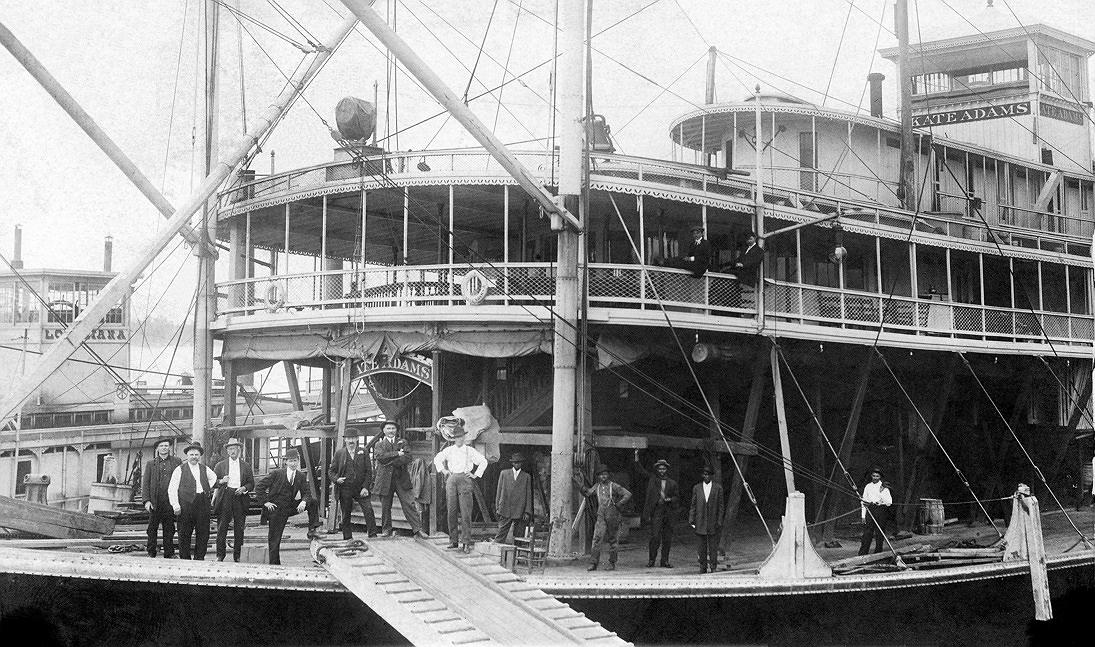
KATE ADAMS before being remodeled for the filming of UNCLE TOM's CABIN.
Heaven on Earth
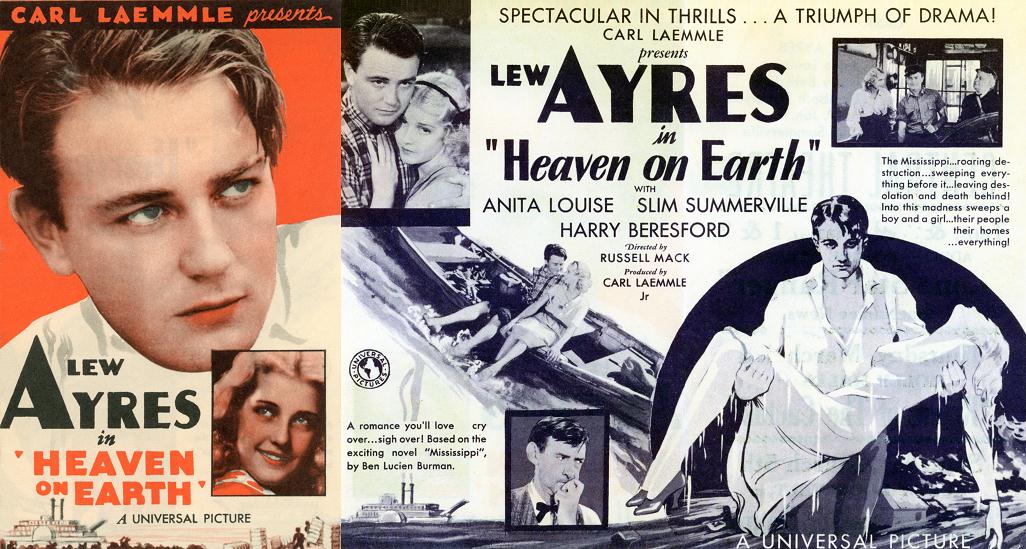
MOVIE REVIEW
Impressive Version of "Mississippi"
By MORDAUNT HALL
New York Times
December 19, 1931
At the Paramount is a worthy and earnest pictorial version of Ben Lucien Burman's novel, "Mississippi," which is known on the screen as "Heaven on Earth."
It is concerned with the poor whites of the lower Mississippi, who believe in spirits, sing their dirges and dwell on floating shanties.
This film, which was directed by Russell Mack, is imbued with an impressive atmosphere, which is heightened by the sincerity of the portrayals of all concerned, especially Lew Ayres, Anita Louise, Harry Beresford and Elizabeth Patterson.
It is a lethargic tale, for the most part, but one that reflects the mood of the people.
There are the shootings, the desire for vengeance, the sudden hatreds and the weird superstitions.
When criticizing the action in a scene, one is apt to reflect that the nature of the people has to be taken into consideration.
They have little imagination, except so far as their spirits are concerned, and one old woman says that the spirits are more accessible in the country than they are up by the court house, which means town to her.
They are uncouth, ragged, and when Towhead, the girl played by Anita Louise, falls in love with States (Mr. Ayres), she begs for help from the spirits.
As for States, he believes himself to be the son of Captain Lilly, of a Mississippi steamboat.
He shoots and wounds Chicken Sam, who then tells him that Captain Lilly killed his (State's) father and adopted him.
Armed with further proof, States forces an admission from Lilly, and the boy, who had been working on the steamboat, leaves his job and joins the folk on the floating shanty town.
The old Captain one day steers his boat for States's ramshackle home and smashes it.
There ensue other troubles, including a challenge to a duel to the Captain from States.
But the Captain, in the end, makes amends and Towhead and States leave the screen as happy as they can be under the circumstances.
HEAVEN ON EARTH, based on Ben Lucien Burman's novel "Mississippi"; directed by Russell Mack: a Universal Production. At the Times Square Paramount and the Brooklyn Paramount.
States . . . . . Lew Ayres
Towhead . . . . . Anita Louise
Captain Lilly . . . . . Harry Beresford
Vergie . . . . . Elizabeth Patterson
Merchant . . . . . Slim Summerville
Butter Eye . . . . . Air P. James
Preacher Daniel . . . . . Harlan Knight
Dr. Boax . . . . . Jack Duffy
Chicken Sam . . . . . John Carradine
Marty . . . . . Robert Burns
Andy . . . . . Lew Kelly
Buffalo . . . . . Jules Cowles
Maggie . . . . . Louise Emmons
Voodoo Sue . . . . . Madame Sul-te-wan
Steamboat Round the Bend
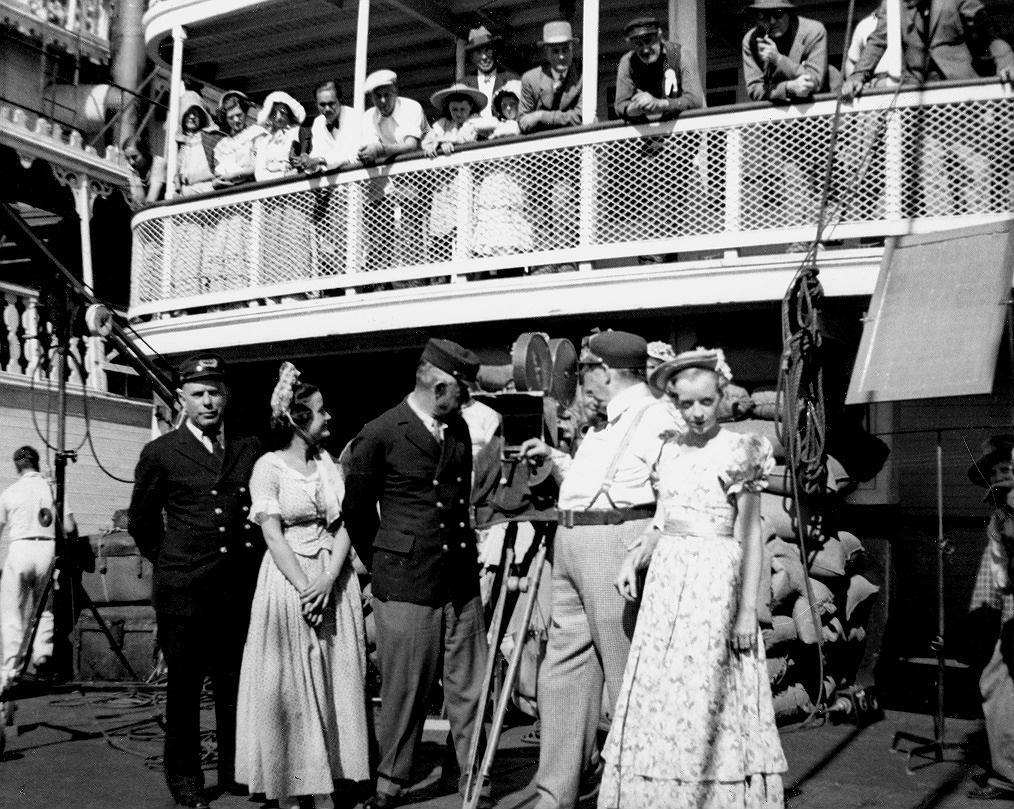
The best of several snapshots taken during the filming of STEAMBOAT ROUND THE BEND!
Here we are on the deck of the PRIDE OF PADUCAH just before the race began.
The CLAREMORE QUEEN is on the left. A buxom brunette in period costume stands between two actual Sacramento River steamboat Captains in their uniforms. Those Captains were the real pilots who steered the boats during the race.
Irvin S. Cobb in costume as Captain Eli stands without his coat, wearing his cap and suspenders as he leaned on the motion picture camera with a cigar in his right hand and with his left hand he's holding on to the wrist of a little blond in period costume. Francis Ford (in his costume as Engineer Efe) stands on the boiler deck above Cobb. To the left of Francis is his brother John Ford, Director of the movie (!), wearing a hat, dark glasses and smoking a pipe.
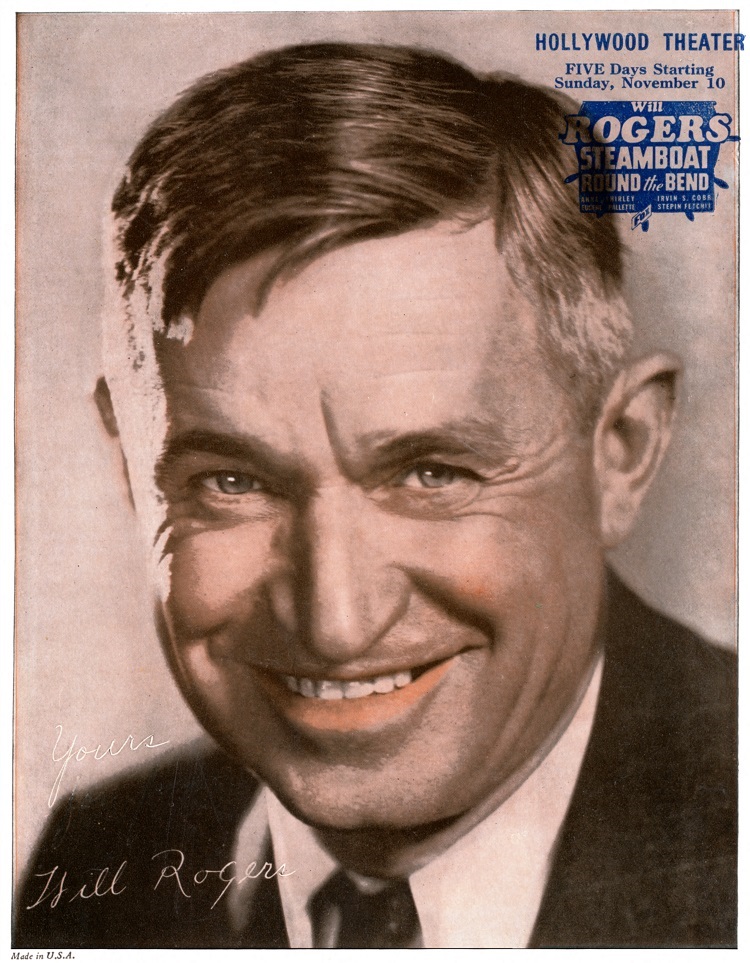
Will Rogers promotional picture for STEAMBOAT ROUND THE BEND NOVEMBER 1935
Will Rogers promotional flyer
For screenings of the movie that began on Sunday the 10th of November 1935 through Thursday the 14th of November at the Hollywood Theater:
Hollywood Theatre
6764 Hollywood Boulevard
Los Angeles, CA 90028
losangelestheatres.blogspot.com
Opened: December 20, 1913 as Hollywood's second theatre with the initial admission price of 10 cents. The facade was of white glazed brick with marble tile in the lobby. The auditorium featured Corinthian columns and a coffered ceiling. The owner of the project was H.L. Lewis. The Idle Hour had been the first theatre to open in Hollywood, in late 1910 or early 1911.
By 1950 Metropolitan Theatres was the operator. The Hollywood was later operated for years by Fox West Coast and its successor companies NGC and Mann Theatres. Frequently it was used as a moveover house from the Chinese. It was a grind operation for a while under NGC. Mann did a remodel in 1977 (including a 70mm installation) for a moveover of "Star Wars." "Blade Runner" also had a good run here in 1982.
Architects: Kremple and Erkes did the building originally. Evidently there was a minor remodel in 1927. S. Charles Lee and Clifford Balch (together?) supposedly did a renovation in 1936 and replaced the original white brick facade with a deco version. The signage currently on the building is from that remodel. Stories so far about who did 30s remodel work (and when) is sketchy and contradictory. On the Cinema Treasures site there's also a mention of Claud Beelman being involved in the remodel work, possibly just the interior, and they use 1938 as the date for that.
Status: The theatre closed in 1991 and was remodeled as a Guinness Book of Records museum. The marquee, vertical and some exterior detail are the only features remaining.
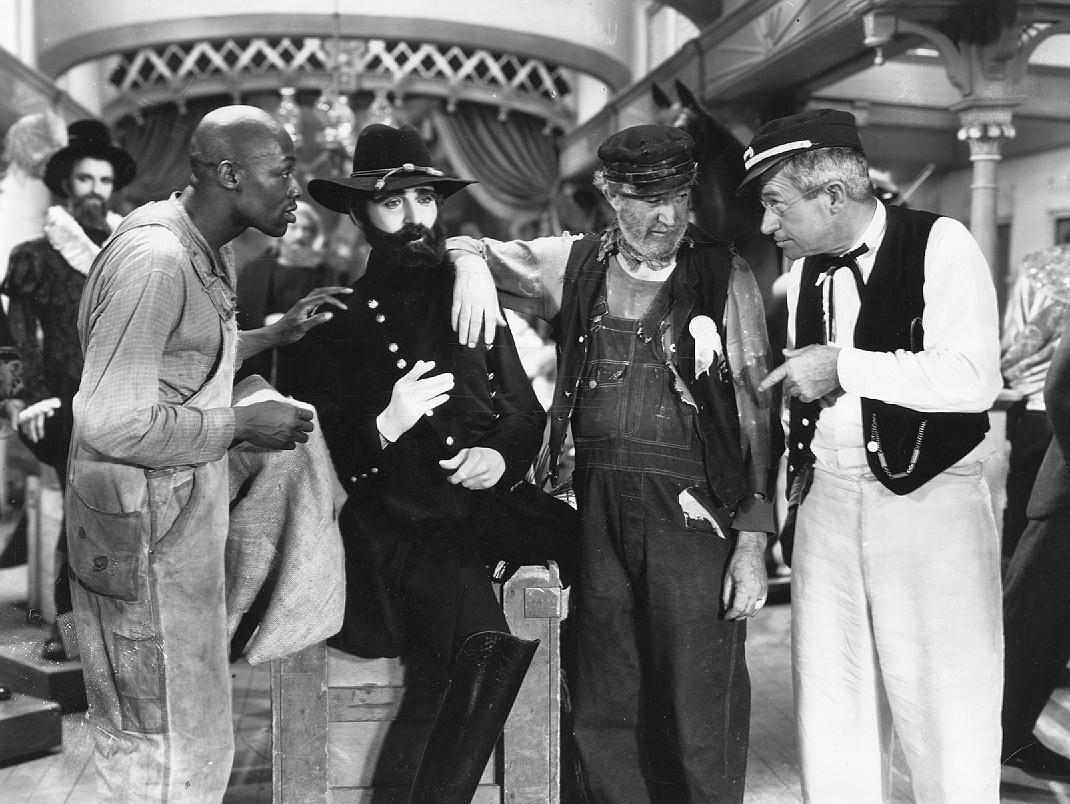
Rogers is telling Francis Ford as EFE how to improve the waxwork of General U.S. GRANT.
"We'll take that old seegar out of his mouth and make him Robert E. LEE!"
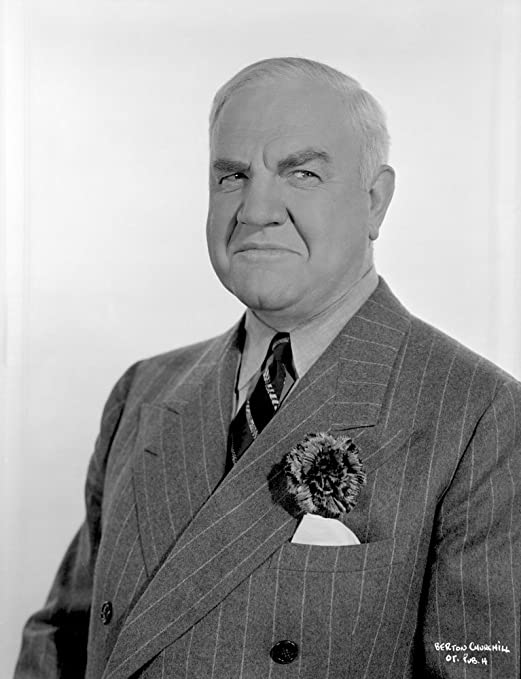
Wikipedia
Berton Churchill (December 9, 1876 - October 10, 1940) was a Canadian stage and film actor.
Born in Toronto, Ontario, as a young man interested in the theater, Churchill appeared in stock companies as early as 1903 and later headed to New York City, where he worked as a newspaper pressman, eventually becoming a foreman and leader of his union.
He began an acting career that saw him perform in 30 plays, many of them on Broadway. He was one of the earliest members of Actors Equity and sat on the union's Council. In 1919, he was in charge of the New York headquarters during the Equity strike in which fellow Canadian, friend and actress Marie Dressler assumed a major part with him, which led to her being blacklisted by the producers.
With the advent of filmmaking in New York, Churchill appeared in several motion pictures, and in the 1920s, following the use of sound in film, he moved to Hollywood, California. There, he landed numerous supporting roles, usually as the stern or pompous character with such roles as a banker, a state governor, or a land baron. He was much in demand, "establishing what was believed to be a record by appearing in 34 in 1932 alone."
In more than 125 films, Churchill worked for some of the great directors such as Otto Preminger, John Ford, and Frank Capra. As well, he performed with many of the most famous stars of the day, such as Bette Davis (The Cabin in the Cotton), Jeanette MacDonald, Tyrone Power, Edward G. Robinson, and Will Rogers. Churchill is perhaps best known for his role as Gatewood, the absconding banker in John Ford's highly acclaimed 1939 film Stagecoach, starring John Wayne.
In 1925, Churchill helped found the Masquers club that led to him and five other actors creating the Screen Actors Guild in 1933.
Churchill died in New York City, of uremic poisoning. He was survived by his wife and daughter. His body was returned to the west coast to be interred in the Forest Lawn Memorial Park in Glendale, California.
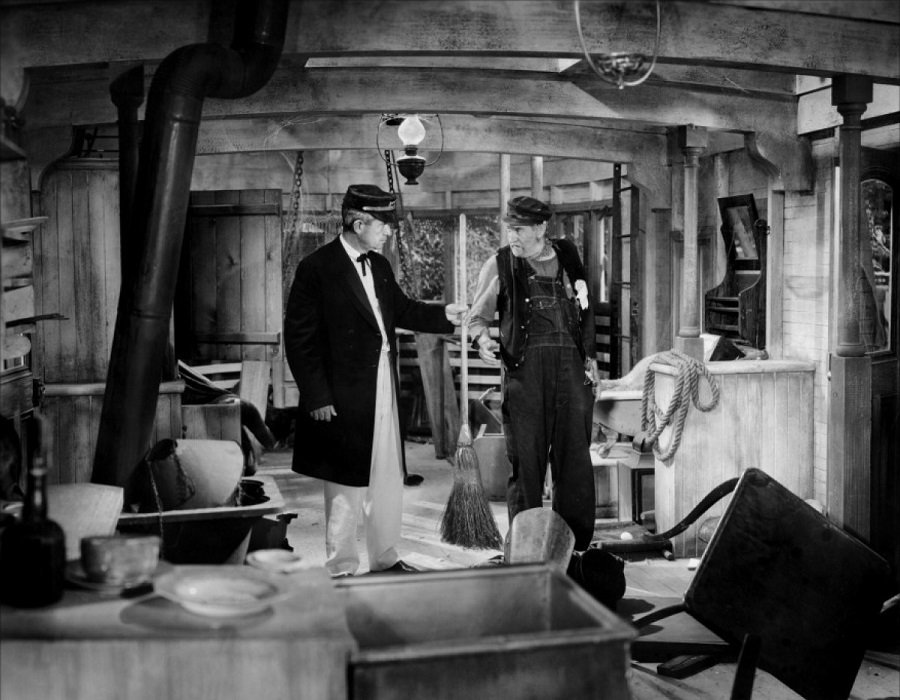
WILL HANDS FRANCIS A BROOM AND SAYS SOMETHING LIKE "NOW FLIRT WITH THAT."
Showboat 1951
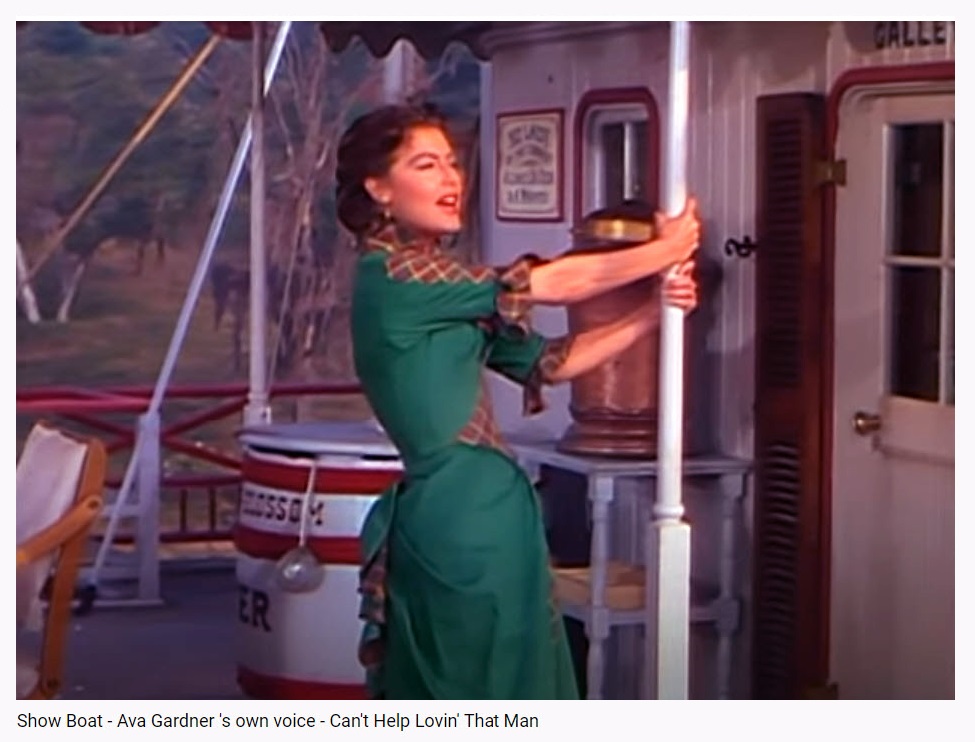
The following two videos let us see and hear Ava Gardner sing what would have been her two unforgettable solos for MGM's SHOW BOAT in 1951.
Ava's sultry, purring voice is subtle and powerful, an acting as well as a singing performance, but MGM decided that instead they needed a "professional vocalist" to dub over her voice with a much less effective one. An excerpt from Ava's memoir below lets her share with us the deep hurt and injustice she felt when her performances weren't present in the original release of the film but ended up on the sound track LP which sold very well in part because her voice was on the album.
Show Boat - Ava Gardner 's own voice - Can't Help Lovin' That Man
March 2, 2013
Lost Vocals
Youtube
Here's Ava's own vocal track for this great song - she was dubbed by Annette Warren in the released film. Can someone tell me why??
(Ms. Warren has confirmed that Ava filmed to her own vocal track and that Annette went in later and recorded her track while watching Ava's performance.)
From "Ava: My Story" "Now, I can sing. I do not expect to be taken for Maria Callas, Ella Fitzgerald, or Lena Home, but I can carry a tune well enough for the likes of Artie Shaw to feel safe offering to put me in front of his orchestra. But since Julie's two songs, "Bill" and "Can't Help Loving That Man," are so beloved by everyone, I decided to work as hard as I could to fit the bill. I even found this marvelous teacher, who'd worked with both Lena and Dorothy Dandridge, and we slaved away for several weeks and produced a test record of those two songs. Then, rather nervously, I took my life into my hands and gave the record to Arthur Freed himself, God Almighty of musical productions. I don't think the son of a bitch ever even listened to it He just put it on a shelf and delivered the usual studio ultimatum:
"Now, listen, Ava, you can't sing and you're among professional singers."
So that settled that one. Or did it? Because the singer they'd chosen to dub my singing had a high, rather tiny voice, totally inappropriate when it was paired with my own speaking voice. The studio spent thousands and thousands of dollars and used the full MGM orchestra trying to get this poor girl right. I mean, there was nothing wrong with her in the first place, except for the obvious fact that she wasn't me. Finally, they got Annette Warren, this gal who used to do a lot of my singing off-screen, and they substituted her voice for mine. So my Southern twang suddenly stops talking and her soprano starts singing - hell, what a mess.
When it came to the album version of the movie, things got even worse. Being a great fan of Lena's, I had copied her phrasing, note for note, on my test record. So they took my record imitating Lena and put earphones on her so she could sing the songs copying me copying her. But Metro soon found out that they couldn't legally release the album with my name and image, as they called it, without my voice being part of the package. So then I used earphones to try to record my voice over her voice, which had been recorded over my voice imitating her.
I did it note for note, they wiped Lena's voice off the album, and the record was a success.
That's the way they worked in those days. And I still get goddamn royalties on the thing!"
From Hugh Fordin's book "The World Of Entertainment!": Ava had made up her mind to sing her two numbers herself: no dubbing. Roger Edens decided to audition voice doubles: Marni Nixon, Anita Ellis, Carole Richards and Annette Warren. He found Warren's singing voice best suited as a match for Gardner's speaking voice. When it came to the pre-recordings Gardner still insisted on singing the songs herself. As a precaution a set of tracks was also made by Warren. After a couple of weeks of screening the two scenes for a number of in- and outsiders, Annette Warren was called back to rerecord the songs, now to Gardner's lip-synch.
What ensued until after the production had closed was a kind of a parlor game. Warren's tracks were in; Warren's tracks were out. Gardner's tracks were in, and then they were out; and so on and so forth, depending on the comment of whoever had seen the sequences last. When Simone asked and Jesse Kaye discussed the forthcoming soundtrack album he felt that for reasons of exploitation and sale Ava Gardner's name on the cover would be an added plus. Show Boat cost $2,295,429 and grossed in excess of $8,650,000.
Show Boat - Ava Gardner 's own voice -- Bill
March 2, 2013
Lost Vocals
Youtube
Here's Ava's own vocal track - she was dubbed by Annette Warren in the released film.
Showboat 1936
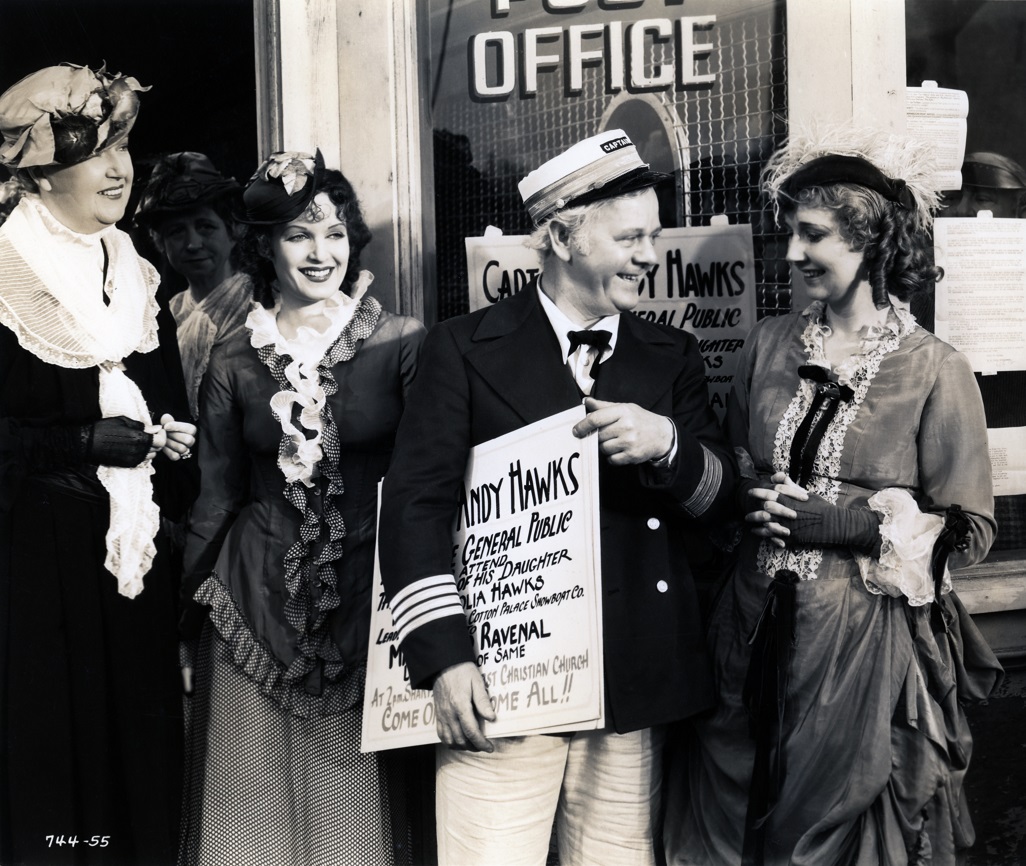
Show Boat 1936 Cap'n Andy inviting ladies to his daughter's wedding
Charles Winninger as Cap'n Andy, always the showman in the 1936 Universal version of SHOW BOAT while he is personally putting up hand-inked posters inviting the townsfolk of Natchez to his daughter Magnolia's wedding to Gaylord Ravenal.
Captain Andy Hawks
Invites the General Public
to attend
The Wedding of his Daughter
Miss Magnolia Hawks
Leading Lady of the Cotton Palace Showboat Co.
To
Mr. Gaylord Ravenal
Leading Man of Same
At 2 p.m. in the First Christian Church
Come One, Come All!!
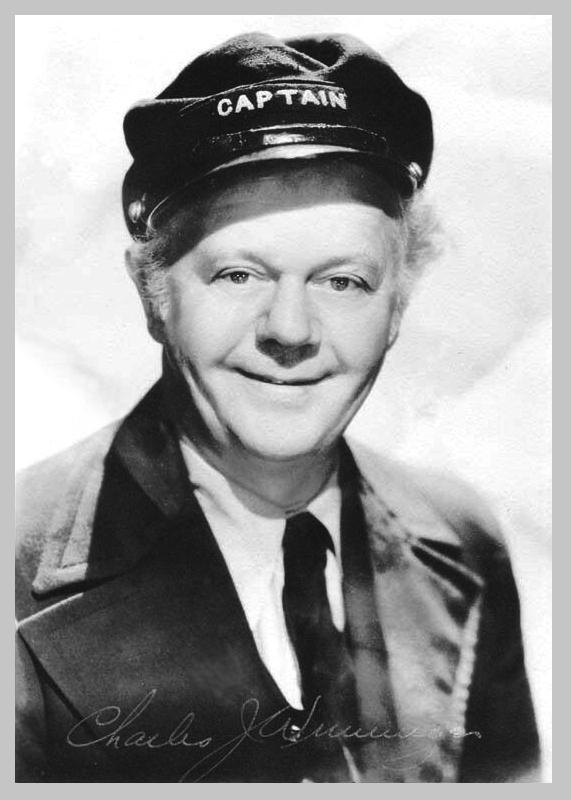
Autographed photo of Charles Winninger as "Cap'n Andy" which may have been taken during his Broadway run as the character in the 1927 hit musical SHOW BOAT, the 1936 film version of the musical or for publicity promoting the 1937 radio program MAXWELL HOUSE SHOW BOAT.
Winninger became so identified with the role and with his "persona" as a riverboat captain that he played several variations of the role, notably on the radio program Maxwell House Show Boat in 1937 which was clearly inspired by the Broadway musical.
Winninger was afforded a rare starring role as Judge Priest in John Ford's wonderful 1953 movie The Sun Shines Bright (1953). Will Rogers created the title role of Judge Priest in John Ford's 1933 movie based on a fictional character created by Rogers' friend Irvin S. Cobb who played Cap'n Eli opposite him in John Ford's 1935 STEAMBOAT ROUND THE BEND.
Biography of Winninger by Hal Erickson: allmovie.com
Born with show business in his blood, Charles Winninger was nine years old when he joined his parents' vaudeville act, the Winninger Family Novelty Company.
The troupe appeared at the Chicago World's Fair of 1893, then spent the next sixteen years touring the provinces.
Going out as a "single" in 1909, Winninger trod the boards as a monologist, dialectician, singer, dancer, dramatic actor and master of ceremonies.
He made his Broadway debut as a German comic in 1912's Yankee Girl Company.
Three years later, he launched his film career at the L-KO comedy studios.
The character-actor phase of his Hollywood years began in 1924, though at the time he was still more committed to the stage than film.
In 1927, he scored one of his biggest Broadway successes as Cap'n Andy in Show Boat, a role he repeated with gusto in the 1936 film version.
Except for occasional Dutch-comic turns in such films as Soup to Nuts (1930) and Friendly Enemies (1945) Winninger was generally seen in talkies in "foxy papa" or roguish-reprobate roles.
His own favorite screen part was Deanna Durbin's roving-eyed millionaire father in Three Smart Girls (1936) and its three sequels.
Winninger's performance as the drink-sodden, grudge-bearing general practitioner in Nothing Sacred (1937) is perhaps his finest cinematic hour, with his portrayal of Iowa farmer Abel Frake in State Fair (1945) running a close second.
Usually billed at the top of the supporting cast list, Winninger was afforded a rare starring role as Judge Priest in John Ford's wonderful The Sun Shines Bright (1953).
On TV, Winninger co-starred in the 1956 sitcom The Charles Farrell Show as Farrell's dad, and guested as Fred Mertz' down-and-out vaudeville partner in the "Mertz and Kurtz" episode of I Love Lucy.
Charles Winninger was at one time married to Broadway favorite Blanche Ring, meaning that he was briefly the brother-in-law of silent screen star Thomas Meighan and comedienne Charlotte Greenwood.
Huck & Tom Movies
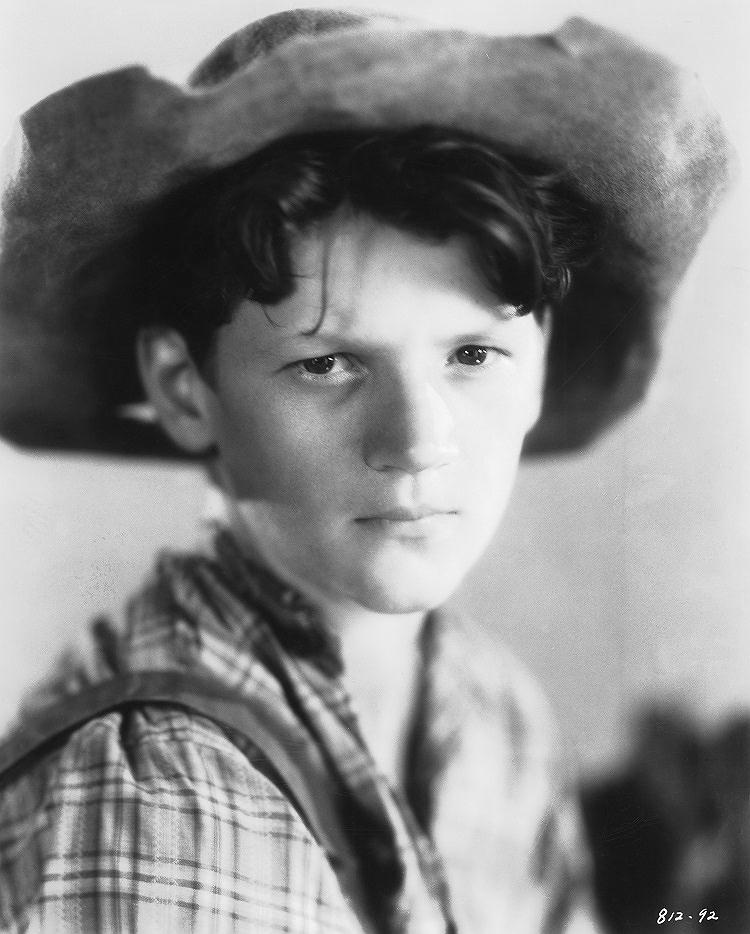
Paramount Portrait:
Junior Durkin as Huck Finn in 1930 for the first "talkie" version of Tom Sawyer.
Photo by studio photographer Richee. More background on Durkin and Richee follows . . .
imdb.com
Junior Durkin (born Trent Bernard "Junior" Durkin in Atlantic City, New Jersey July 2, 1915) became life-long friends with superstar Jackie Coogan when he tested and won the role of Huckleberry Finn opposite Coogan's Sawyer in what would prove to be a highly popular movie version of the Mark Twain classic Tom Sawyer (1930). Both boys were the same age. With Mitzi Green delightful as Becky Thatcher, the three young actors received heaps of praise for their naturalistic performances. The movie was so well received, in fact, that all three were reunited in the film version of Huckleberry Finn (1931). Blessed with a shy, ingratiating smile, Junior, along with the other two, received equal applause for these same roles.
Junior had just been cast to play "Tommy" in the hotly anticipated film version of Eugene O'Neill's drama Ah Wilderness! (1935) when he decided to take some time off to relax with his good friend Jackie Coogan at the Coogan ranch just outside San Diego. On their way back to the ranch while out on a dove-hunting expedition one day in Coogan's new car, a 20th birthday present from his dad, the vehicle (driven by Coogan, Sr.) swerved to avoid an oncoming car, lost control and plunged into a ravine, overturning more than seven times. Of all the occupants -- Jackie, Jackie's father, Junior, actor-writer Robert J. Horner and ranch foreman Charles Jones -- young Jackie Coogan was the sole survivor, the only one not thrown from the car. Junior's death was attributed to a fractured skull.
Live Theatre
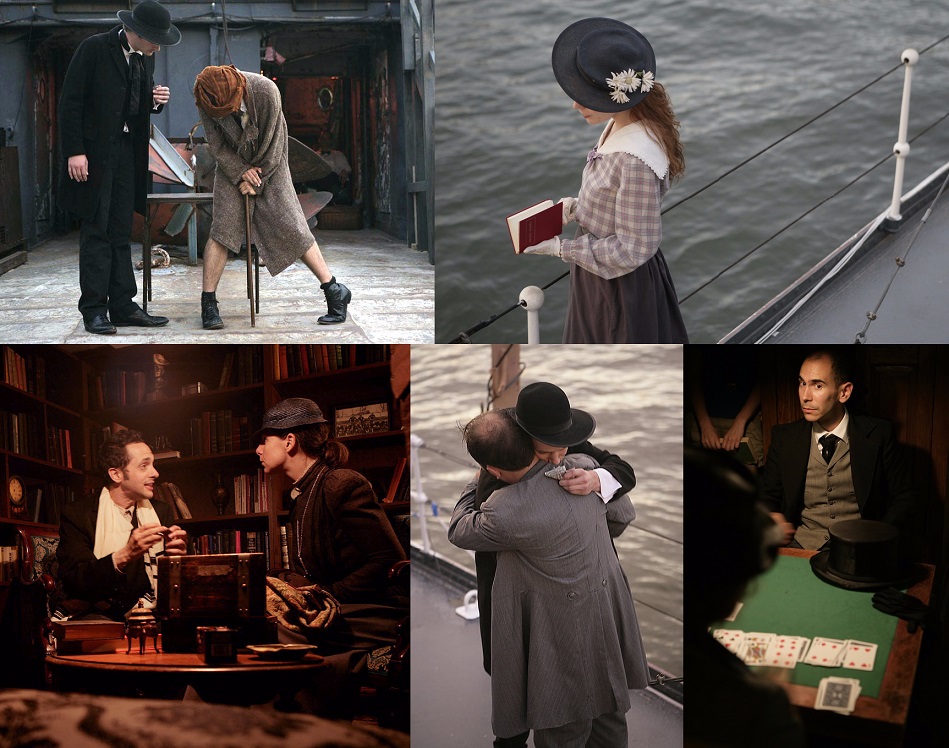 The Confidence Man inspired by Herman Melville's novel of colorful steamboat passengers
The Confidence Man inspired by Herman Melville's novel of colorful steamboat passengers
September 16, 2009
The Confidence Man
It's a good thing "The Confidence Man" is free -- it requires at least three viewings.
By Sam Thielman
It's a good thing "The Confidence Man" is free—it requires at least three viewings. Not because it's particularly obtuse or dense, but because there are three different, dovetailing strands of playlets in simultaneous motion aboard the former steam driven Coast Guard Tender LILAC, a rusty old tub that sits at Pier 40 on the Hudson.
Nominally inspired by Herman Melville's novel of colorful steamboat passengers, Paul Cohen's gratifyingly ambitious script manifests itself less as a single play than an impressively cohesive piece of installation art about swindling, literally buoyed by the verisimilitude of its maritime setting.
Led around the ship by one of six docents, audience members follow three or four of the 16 storylines that play at different places and times around the elderly vessel—climbing stairs, ducking into tiny cabins, and embarrassedly turning their backs as one guide makes a lengthy phone call to the student she's extorting. Some of these pieces are as elaborate as a good thriller—the grad student bit is particularly inspired, as is the old-timey two-man con starring a salesman of holy relics and his accomplice, a crooked rabbi. Others are simply one-off monologues about dishonesty, frequently on the part of the teller.
The writing varies from bit to bit; many of the 31 performers seem to feel understandably less at ease spouting unconvincing "period" dialogue than running the more contempo lines. Cohen's ending, which puts a bow on the proceedings, is also a little problematic, mostly because of the show's diffuse, labor-intensive concept and execution. As a whole, "The Confidence Man" works well enough to make a pat ending feel redundant. The vignettes, all blocked and assembled very well by a team of three directors (Stephen Brackett, Lauren Keating and Michael Silverstone), are thematically cohesive without it, though one supposes some kind of conclusion was essential to signal auds when it's time to get off the boat.
But the writer comments intelligently on the novel itself, which is chiefly concerned with multiple perspectives on grifting, including that of the grifter himself. In the play, Cohen shuffles timelines, but he always maintains the spirit of the book, whether it's in a couple of doctoral candidates (Roger Lirtsman and Emily Perkins) discussing Melville or an earnest financial executive (Melissa Miller) encouraging her clients to stop worrying and trust their Madoff-like benefactor (Jacob Grigolia-Rosenbaum).
Since there's a cast of literally dozens, it's impossible to do all the actors justice, but Grigolia-Rosenbaum and Miller are notably good, and all the actors roll with the continuous challenge of a dozen people standing wherever they please while the scenes take place.
With only beer sales (not recommended—ladderlike stairs plus the vessel's mild swaying are plenty perilous sans booze) to keep the good ship Woodshed Collective afloat, it's a wonder this tiny company is able to mount such a huge entertainment. And it's heartening that they've pulled it off.
The Confidence Man
WAGL 227 LILAC; 55 seats; free
Production:
A Woodshed Collective presentation of a play in one act by Paul Cohen, inspired by the novel by Herman Melville.
Directed by Stephen Brackett, Lauren Keating and Michael Silverstone.
Creative:
Sets, Sara Walsh, Daniel Zimmerman
costumes, Jessica Pabst
lighting, Zack Brown
sound, Daniel Kluger, Brandon Wolcott
production stage manager, Colin Miller.
Opened Sept. 16, 2009. Reviewed Sept. 10.
Running time: 1 HOUR, 45 MIN.
Cast:
Ben Beckley, Kate Benson, Pepper Binkley, Felipe Bonilla, Rusty Buehler, Juliette Clair, Eric Clem, Dan Cozzens, Todd D'Amour, Danny Deferarri, Aaron Dias, Matt Dickson, Nicholas Feitel, Emmitt George, Chris Gliege, Lara Gold, Laurel Holland, Jocelyn Kuritsky, Jane Lee, Roger Lirtsman, Moti Margolin, Brendan McDonough, Melissa Miller, Heidi Niedermayer, Emily Perkins, Michael R. Piazza, Mallory Portnoy, Jacob Grigolia-Rosenbaum, Hugh Sinclair, Gina Vetro and Lee Zarrett.
"During the three years I've been covering theater for Gothamist, I'm quite confident I've never deployed the oft-overused word 'genius' to describe a production. So then perhaps you'll trust me when I tell you The Confidence Man is most definitely a work of dazzling genius, a spellbinding feat of collective creativity."
- GOTHAMIST
"☆ ☆ ☆ ☆ ☆!" - TIMEOUTNY
"An impressively cohesive piece of installation art"
- Variety
"Heartbreakingly beautiful"
- NYTHEATRE.COM
As disarmingly relevant today as it was in the 19th century, The Confidence Man begs the question: in whom may we safely place our confidence?
In light of recent economic events surrounding Bernard Madoff, sub-prime lenders, and the deflating of the real estate bubble, confidence is a word on many minds these days. President Obama included the theme in his 2008 inaugural address, noting a profound "sapping of confidence across our land - a nagging fear that America's decline is inevitable, and that the next generation must lower its sights."
Woodshed Collective's production of The Confidence Man was composed of a series of interwoven and simultaneously performed vignettes throughout the ship, evoking the whirlwind of both a riverboat journey and the everyday urban chaos of New York City. Inspired by Herman Melville's iconoclastic novel, the show pushed the company's boundaries by allowing audience members to immerse themselves in the experience, the production seeks to blur the line between performer and patron, reclaim confidence in the power of live theater, and leave the lingering impression that the audience members themselves may not be immune to the confidence man's charms or cons.
Act II for steamship LILAC
By Soundings Editors
soundingsonline.com
The most recent show to walk the LILAC's deck was New York director Adam Klasfeld's production "The Report of My Death," a one-man show about Mark Twain's life that had its final performance Aug. 22. Originally posted Dec 31, 2009 Updated: Jun 16, 2017 The deck of a 1933 steamship is not a conventional place to perform a play, but if you believe William Shakespeare, all the world's a stage.
In the efforts to raise funds for the restoration of LILAC, a 173-foot steamship that served as a lighthouse tender for the U.S. Lighthouse Service from 1933 to 1939, the LILAC Preservation Project has opened up the buoy deck as a venue for cultural and artistic events. "We are in the preservation stage to keep her from deteriorating further," says executive director Charlie Ritchie.
"We're trying to refurbish the state rooms, wheelhouse, captain's rooms and, of course, eventually get her engines running again." The LILAC is docked at Pier 40 on the Hudson River in the South Village of New York City.
"For the most part she is about 75 to 80 percent intact," says Ritchie. "She has one of the last intact steam engines left."
Though her engines are not functional at this point, Ritchie is hopeful she will be on the water again. Restoring a historic steamship is a big job, but fortunately in the case of Lilac, there are plenty of inner-city high school kids willing to lend a hand.
Ritchie has run the Maritime Adventure Program since the beginning of 2007, an after-school internship for high school students ages 14 and up that helps to restore the LILAC.
Students also participate in the Summer Youth Work Program where students are paid minimum wage for doing restoration work on the LILAC. The program is organized through the New York Department of Youth and Community Development. "When I tell the kids that they are responsible for 80 percent of the restoration work since 2007, they can't believe it," says Ritchie. "But they get so much more done than just a handful of adults, most of whom don't have a lot of time to devote."
The non-profit Tug Pegasus Preservation Project in New York City began negotiations to purchase the vessel in 2002 and she was dry-docked at a shipyard in Norfolk, Virginia, to have her hull inspected. Upon a favorable review, she was purchased Feb. 25, 2003, and docked where she resides now at Pier 40.
"For the first three or four years no one really did anything with her," says Ritchie. "I was involved doing events with the kids, doing a Halloween haunted ship for instance, off and on for about four years before I became executive director in 2007."
Ritchie, who has had a longtime interest in canoeing and rowing boats, is also something of a thespian. He attended acting school for three years and thought one way of raising funds for the boat was to use it as a venue for plays.
"The buoy deck can accommodate 60 or 70 people and you can fit even more on the upper deck," says Ritchie.
The most recent show to walk the deck was New York director Adam Klasfeld's production "The Report of My Death," a one-man show about Mark Twain's life that had its final performance Aug. 22.
"I found an ad . . . on Craigslist, offering the ship to art venues," says Klasfeld, who is also the playwright. "Since much of the play recounts Mark Twain's world tour [in 1895] by steamboat, there couldn't have been a more perfect setting."
Actor Michael Graves, who portrayed Twain, says it was a challenge for him each night of the performance to somehow incorporate the outside noises and events into the script to keep the audience involved.
For instance, one time during the play a party boat floated by blaring techno music. Graves (as Twain) casually wandered to the side of the deck and shouted, "And don't come back!" much to the delight of the audience.
Another theatre company called The Woodshed Collective based in Brooklyn presented "The Confidence Man," a play based on the novel of the same title by Herman Melville about con men on a steamship, throughout the month of September.
"It's a much larger production than the Mark Twain play," says Ritchie. "It helps because it gets new people on the ship and aware of her existence and importance."
Ritchie says in October a group from Men's Vogue China used the Lilac for a photo shoot and hopes more art venues will find her a fun and unique place to hold their events.
Meanwhile, Ritchie and the group's historian Norman Brouwer are applying for her to gain status as a National Historic Landmark, which would make her more eligible for federal grant money.
They hope to have the status by spring.
"We don't know how she'll run, but there's also the possibility of her being used as a marine research vessel once her engines are running," says Ritchie.
For information, visit lilacpreservationproject.org
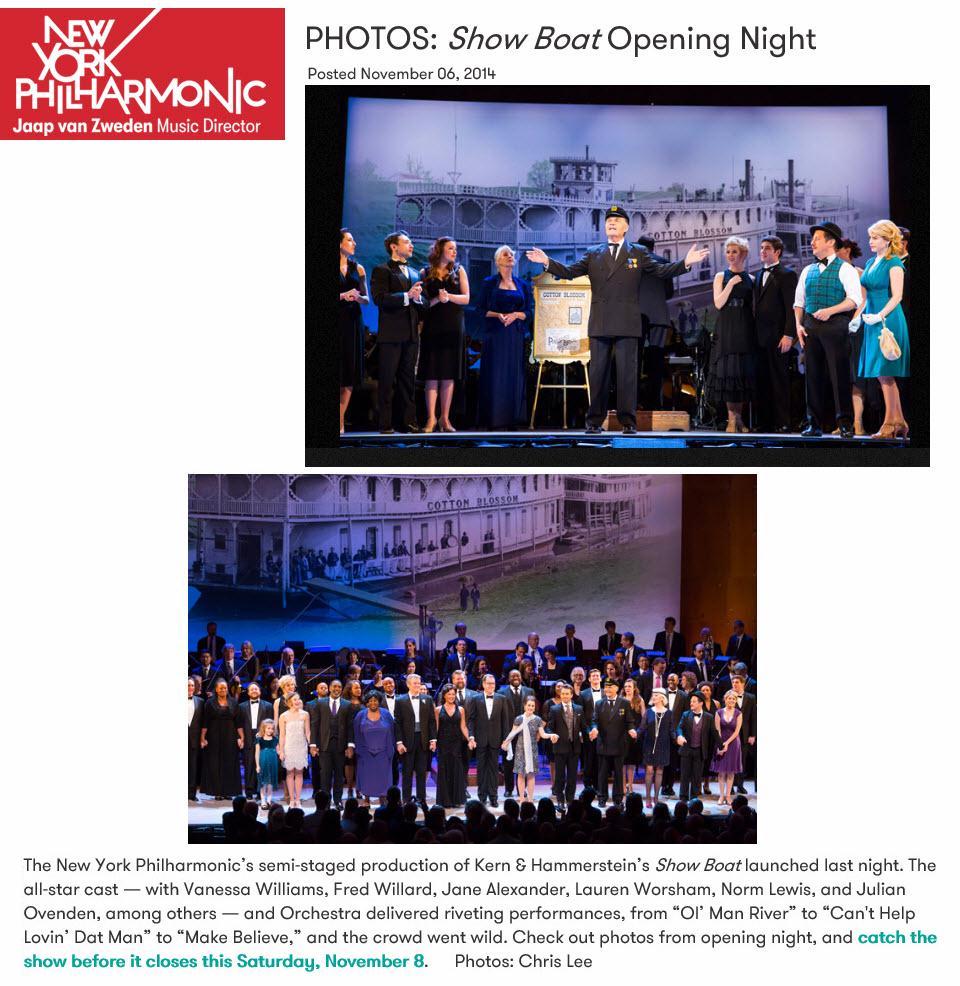
Live From Lincoln Center: Kern & Hammstein's Show Boat in Concert with the New York Philharmonic
Youtube
Live from Lincoln Center: Kern & Hammerstein's Show Boat was featured in the 2015 PBS Arts Fall Festival.
Premiere Date: Friday, October 16, 2015
Both a cultural and artistic watershed, this groundbreaking musical redefined entertainment and changed the face of American theater.
Spanning from 1880 to 1927, Jerome Kern and Oscar Hammerstein II's lyrical masterpiece concerns the lives, loves and heartbreaks of three generations of show folk on the Mississippi, in Chicago and on Broadway. Its impact remains unparalleled, addressing serious subjects like racial prejudice, introducing a bi-racial cast to Broadway, and pointing the way toward a new synthesis between music and spectacle.
With an all-star cast led by Vanessa Williams, Downton Abbey's Julian Ovendon, Tony Award nominees Lauren Worsham and Norm Lewis, and Fred Willard, this New York Philharmonic production highlights the lush musical journey at the center of this epic show.

JULIA BELLE SWAIN at a Missouri River Landing taken during the filming of the musical TOM SAWYER in 1973, from a souvenir program for the film filled with color photographs printe by IPC Project Publishing - London, England '73.
Live Theatre
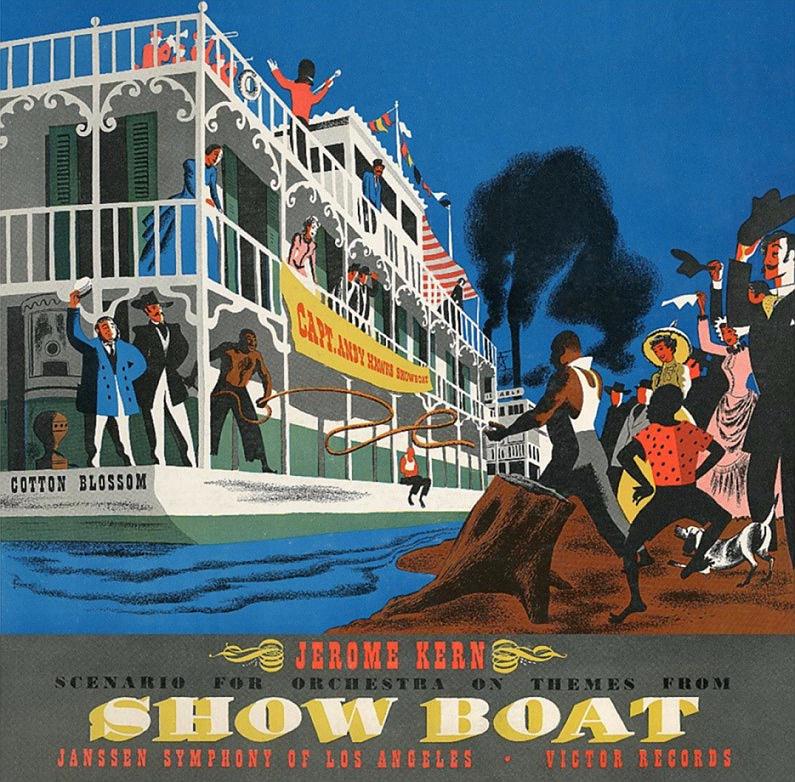
SHOW BOAT ALBUM COVER VICTOR RECORDS - JEROME KERN SCENARIO OF MUSIC FROM HIS OWN MUSICAL
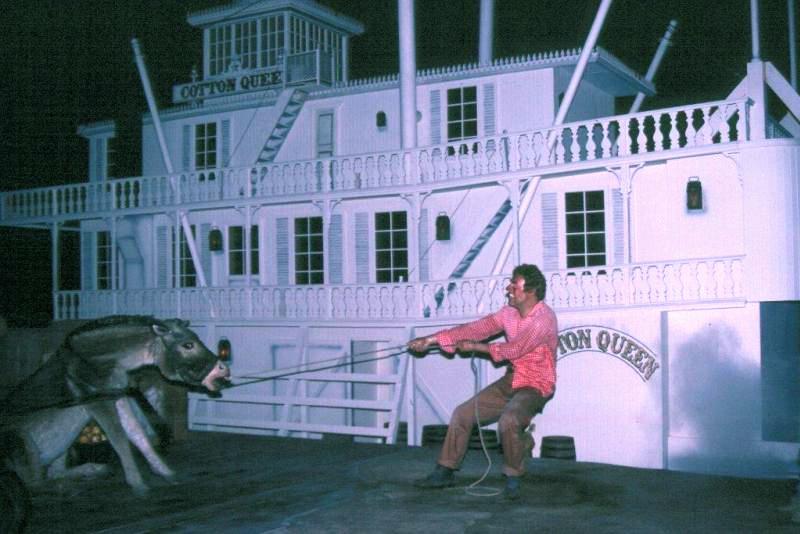
The COTTON QUEEN steamboat mock-up at Disney World's EPCOT 1982 to 1996
The WORLD OF MOTION at Walt Disney World EPCOT sponsored by General Motors, was the former tenant of the Transportation pavilion at EPCOT (Experimental Prototype Community of Tomorrow) in Orlando, Florida. It was an opening day attraction at EPCOT Center in 1982 and closed in 1996.
The steamboat COTTON QUEEN mock-up seen during the ride-through was supposed to demonstrate "the evolution of steam" and featured an audio animatronic roustabout pulling the rope connected to a stubborn mechanical donkey on a wharf at a landing somewhere along the Lower Mississippi.
disneyparks.disney.go.com
by Jennifer Fickley-Baker, Editorial Content Manager
Walt Disney World Resort
Thu, October 15, 2015
"Although it's now just a part of EPCOT's history, World of Motion was one of the park's original attractions that guests flocked to on opening day. The attraction, then sponsored by General Motors, took guests on a time travel journey through the history of transportation - man's foibles and triumphs in designing new vehicles, the age of flight, and the development of the horseless carriage, as well as the transportation trends our culture latched on to like the bicycle, the family Sunday drive, and the summer road trip."
P.S. from Dave: "I don't recall seeing the WORLD OF MOTION during my visit to EPCOT in November 1989 when I was sent down for a week as a consultant to the Florida branch of Walt Disney Studio's Animation studio."
This was part of the Disney-MGM Studios complex of theme parks. Park visitors were able to take a tour of the studio and observe the animators at work. In 1998, the unit moved into a new $70 million faculty. At the studio's height in the mid-1990s, it employed approximately 400 artists and technicians. This branch of the studio was responsible for Mulan (1998), Lilo & Stitch (2002) and Brother Bear (2003), all traditionally hand drawn animated films. Walt Disney Studios closed that branch of the studio in January 2004, putting approximately 250 animators, technicians and other personnel out of work. filmbuffonline.com

With the exception of images credited to public institutions,
everything on this page is from a private collection.
Please contact Steamboats.com for permission for commercial use.*
All captions provided by Dave Thomson, Steamboats.com primary contributor and historian.
